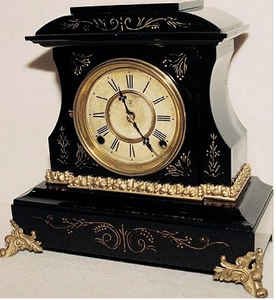In the minds of clock collectors, the name F. Kroeber Clock Company conjures up images of expensive clocks rarely available to the average buyer. The maker of these clocks was Florence Kroeber (1840-1911), who was born in Germany in 1840. He and his family immigrated to the United States in the mid-i8oos and settled in New York City.
At 19, Kroeber was employed as a bookkeeper in the Owen and Clark Clock Store. George B. Owen operated the business when Clark left the company in 1861. Soon, George B. Owen left to become general manager of the W. L. Gilbert Clock Company in Winsted, Connecticut, which gave Kroeber the opportunity to acquire the business. Kroeber then offered imported clocks as well as models made in the United States. He also stocked European novelties. Advertisements during the beginning of the 1870s described Kroeber as an “importer and dealer in French, German and American clocks.”
When a German immigrant sought employment in 1868, F. Kroeber accepted this man, Nicholas Mueller, as a partner. Mueller specialized in producing bronzed cast-metal figurines and inscribed-metal clock cases. This relationship only lasted about a year, however.
F. Kroeber cast-iron black enameled mantel clock, gilded decorations, eight-davtime & strike, ca. 1898, 12 1/2″ h. $300.
Kroeber began to create clock cases. He ordered movements from Connecticut makers. His clock business was successful, and he incorporated it as the F. Kroeber Clock Company. He was successful enough to open a second store in Manhattan’s midtown area. In order to stock his store with interesting novelties, he traveled to Europe in the spring of 1888 to buy a variety of novelties—vases, candelabra, bronze figures, nickel and brass items, woodcased pieces, and plush-covered novelties.
Kroeber created clock cases until 1899. Several, patented in 1869, looked like Victorian picture frames. Sometimes, however, he purchased metal cases from other companies.
He imported marble and china cases, but installed American movements in them. Kroeber also created a new finish, coating cast-iron clock cases so that they resembled porcelain. He called his patented product, “Porcelene.” Soon Ansonia Clock Company produced clocks with the same porcelain-type finish and colors, so Kroeber sued Ansonia for infringing on his patent. In addition, Kroeber patented a pendulum that did not have to be taken off when a clock was moved.
Kroeber’s 1888 catalog displayed more than 250 clocks, ninety percent of which were made in America. Business dropped after the Depression of 1893, though, so Kroeber was forced to close one store and move into smaller quarters. Unfortunately, he went bankrupt in January 1904. After he lost his company, he worked for seven years as a clerk in a store watch and clock department. Kroeber died from tuberculosis on May 16,1911.
Today, people who enjoy collecting unique clocks appreciate examples of his quality work. Collectors know his clocks bring higher prices and are more difficult to find than those made by some of the major clock companies.
Some authorities suspect, but have not proved, that Kroeber put his label on some mass-produced American and imported clocks. It is known that Kroeber had a label that read, “F. Kroeber, agent for New Haven, E. N. Welch, Jerome, Seth Thomas and other companies.”
Collectors should carefully inspect clocks reputed to be made by Kroeber. A Kroeber label, dial, or marked Kroeber movement makes a clock desirable as well as costly, but it must be determined that there are no reproduction parts. A specialist in Kroeber clocks can be of great assistance.
As an aid in dating Kroeber clocks, the information that follows may answer questions relating to the age of a specific clock.

